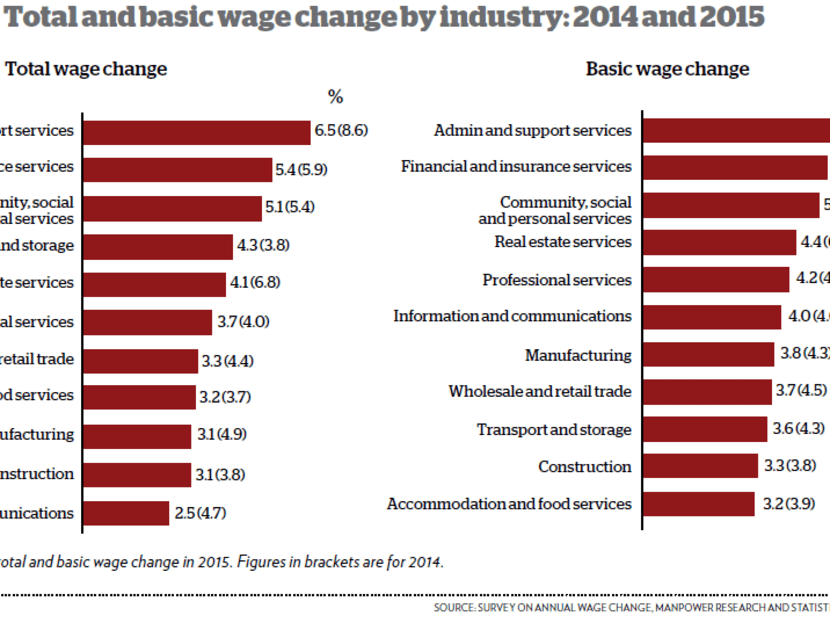Fewer firms made profit, increased pay last year
SINGAPORE — With the global economic downturn casting a shadow over the local business climate, fewer private firms turned a profit or gave pay increments last year.
SINGAPORE — With the global economic downturn casting a shadow over the local business climate, fewer private firms turned a profit or gave pay increments last year.
According to a Manpower Ministry (MOM) wage practices report released on Thursday (June 2), the proportion of firms in the red went up by three percentage points to 21 per cent over the year. Accordingly, 64 per cent of firms gave pay increments last year, down from the 72 per cent that did so in the previous year.
The bright spots were in administrative and support services; financial and insurance services; and community, social and personal services, which saw the biggest growth in wages, similar to 2014. Total wage growth in these sectors ranged from 5.1 per cent to 6.5 per cent.
At the opposite end was manufacturing, construction, and information and communications, where wage growth ranged from 2.5 per cent to 3.1 per cent. The infocomms industry, in particular, saw wage growth slowing drastically from 4.7 per cent to 2.5 per cent over the year.
Unlike in 2014, total wage growth for rank-and-file workers (3.9 per cent) trailed behind non rank-and-file workers (4.1 per cent) last year. The MOM attributed this to a greater moderation in the wage growth of rank-and-file workers.

(Click to Enlarge)
The economy grew 2 per cent last year, the weakest rate of growth since 2009. According to the MOM report, about two in five firms (41 per cent) raked in an equivalent or higher amount of profits, down from half of the firms surveyed in 2014.
Around two in five (38 per cent) firms saw lower profits than before, up from about three in 10 (32 per cent) in 2014.
Nine in 10 private sector workers were under a flexible wage system last year, the highest since 2004, while wage increases declined from 6 per cent to 5.6 per cent over the year.
The proportion of firms freezing wages grew, from one in five to one in four. And a larger proportion of firms cut wages over the year, while the cuts became steeper, growing from 3.9 per cent to 4.7 per cent over the year.
Singapore Business Federation chief executive Ho Meng Kit said that this year’s outlook remained uncertain, although more firms reported lower profits last year. Industries that have seen more subdued wage growth include the manufacturing and trade-related sectors, which have been affected by weaker external demand, he said.
Given tightening purse strings, areas such as professional services, building construction and fine dining were likely to be worst hit, said Mr Kurt Wee, president of the Association of Small & Medium Enterprises (ASME).
For professional services specifically, Mr Wee foresees consumers pushing for discounts, even as the volume of work declines.
“The focus should be placed on ensuring that SMEs survive. If there’s no wage increase, at least employees are keeping their jobs. If businesses don’t survive now, definitely they can’t sustain their jobs. That’s even worse,” he said.
Mr Wee added that in recent years, there has been much restructuring in cleaning, security and landscape, which fell under the Progressive Wage Model. He said: “On the other hand, productivity has not really gained. The workforce must also remember that productivity gains have to commensurate with wage increase. And if productivity is falling, the whole question is should we have a wage reduction?”
On the slowdown in wage growth in the infocomms industry, Mr Wee pointed out that projects might have been given to overseas parties. “I expect recovery in this sector, with business demand for moving processes online still in motion,” he said.
The growth of nominal wages slowed from 4.9 per cent to 4 per cent over the year. But real wages rose by 5.4 per cent, more than the 3.9 per cent growth in the preceding year, after factoring in inflation and employer Central Provident Fund (CPF) contributions, which increased by one percentage point last year.
The report was based on data from the annual wage changes survey, which had a response rate of 92 per cent, covered 5,100 private firms, and about 1.3 million employees.







